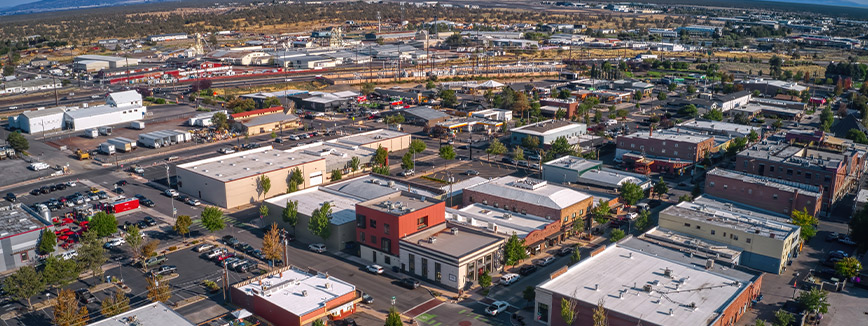Moving from Idaho to Oregon in Fall: Tips for a Smooth Relocation
So, you’ve decided to leave Idaho and head west to Oregon this fall. First off, good timing! Summer moving madness has died down, the air is cooler, and you’ll likely snag better rates on movers or rentals. But moving in autumn has its quirks too: Oregon’s rainy season begins in earnest around late October, daylight shrinks fast, and mountain passes can get foggy.
This guide on moving from Idaho to Oregon will walk you through everything: choosing movers, budgeting, handling paperwork, adjusting to the Oregon lifestyle, and even what to pack for your pets.
Moving From Idaho to Oregon: Cost of Living and Lifestyle Snapshot

| Category | Idaho | Oregon | What to Expect After Moving |
| Housing | More affordable, larger homes | Higher in Portland/Bend, moderate in smaller towns | Likely higher rent/mortgage unless choosing rural Oregon |
| Taxes | Flat 5.8% income tax, 6% sales tax | Progressive income tax up to 9.9%, no sales tax | Groceries/shopping cheaper, income tax higher |
| Utilities | Slightly higher average bills | Lower thanks to hydropower | Savings possible, esp. on electricity |
| Groceries & Dining | Lower overall | Higher in urban areas, a strong farm-to-table culture | Expect pricier dining out, better local options |
| Transportation | Lower gas prices, car-centric | Higher gas prices, mix of transit, bike-friendly | Public transit/biking is more viable in cities |
| Weather | Dry summers, snowy winters | Rainy, mild winters (west), dry (east) | Pack rain gear; fall = drizzle season |
| Culture & Lifestyle | Traditional, family-oriented | Progressive, eco-conscious, outdoor-focused | Adjust to sustainable, community-driven habits |
Downsizing and Pre-Move Prep
Before you even book a truck, take a good look around your home. Oregon housing, especially in Portland and Eugene, tends to be tighter on space than Idaho’s larger houses. Downsizing now saves you money on moving costs and stress later.
Pro tip: Fall is yard-sale season in Idaho. Host a weekend sale to clear out extras — furniture you won’t use, old sports gear, or that treadmill collecting dust — and use the cash to offset moving expenses. For anything left over, donate to local thrift shops or shelters. Oregon has a strong “reuse culture,” so you’ll fit in before you even arrive.
Timeline Planning
Relocations run smoother when you give yourself milestones.
- Two months out: Research movers, compare quotes, and book your preferred date. If you’re renting, notify your landlord. Start sorting what stays and what goes.
- One month out: Forward your mail, switch utilities, and collect school, vet, and medical records. Confirm details with movers.
- Moving week: Pack your essentials box (think chargers, snacks, paperwork, and a rain jacket), keep an eye on weather forecasts, and prep your car for the road trip.
Breaking it down like this keeps overwhelm at bay.
Packing for Fall Weather
Oregon’s autumn isn’t just damp, it’s persistently damp. That means your packing strategy should go beyond cardboard boxes and tape.
- Waterproof boxes and wrap: Line boxes with heavy-duty trash bags, shrink wrap large furniture, and tape extra around seams.
- Protect electronics: Use bubble wrap and seal gadgets in plastic before boxing. Moisture is no friend to laptops or gaming consoles.
- Clothing strategy: Keep sweaters, rain boots, and a waterproof jacket in an “open first” bag. You’ll need them before you even unpack.
Think of your move as part logistics, part weatherproofing project.
Choosing the Right Oregon Movers

Since you’re crossing state lines, you’ll want movers licensed for interstate relocations. In Oregon, movers must be certified by the Oregon Department of Transportation, which ensures pricing transparency and proper insurance. Always check credentials before signing contracts.
Ask movers about their rainy-weather protocols. Do they provide floor runners for muddy shoes? Waterproof furniture pads? If not, you may want to DIY those parts. For smaller moves, consider portable containers, but remember, you’ll be the one loading and unloading in the drizzle.
Tackling the Paperwork
Moving across state lines means fresh paperwork. Put these high on your list:
- DMV: Oregon requires vehicle registration and a new driver’s license within 30 days.
- Taxes: Oregon has no sales tax (yay!) but a higher income tax than Idaho. Plan ahead if you work remotely or own a business.
- Voter registration: Since Oregon votes by mail, update this as soon as you arrive.
- Healthcare: Double-check that your provider network covers Oregon. If not, scout out new doctors before you need them.
Do these early. You’ll thank yourself later.
From Idaho to Oregon: Lifestyle Shifts
Moving isn’t just about addresses, it’s about adapting to a new rhythm.
- Housing: Idaho generally offers more space for less money. Oregon homes, especially near Portland, come with a higher price tag, though smaller towns are more affordable.
- Culture: Idaho leans traditional; Oregon thrives on progressive values, eco-conscious living, and strong community involvement.
- Weather: Idaho = four seasons, dry summers. Oregon = misty, green, and damp, especially west of the Cascades.
The good news? Both states share a love for the outdoors. You’ll just be swapping Idaho’s wide skies for Oregon’s mossy forests and waterfalls.
Moving with Kids
Families have extra logistics. Oregon’s school year starts in early September, so a fall move means kids might enter mid-term. Collect transcripts and immunization records before leaving Idaho. Research your new school district. Portland, for example, has a school-choice system, while smaller towns assign schools by neighborhood.
Getting kids into sports, clubs, or after-school programs early can help them settle faster. Oregon excels in outdoor youth activities, from soccer to hiking clubs, which can make the transition fun rather than stressful.
Don’t Forget the Pets
Your furry (or feathery) friends need planning, too. Take them to the vet for updated vaccines, request copies of their medical records, and microchip if they aren’t already.
On Pet moving day, keep a pet bag handy with water, food, and a favorite blanket. Oregon is incredibly pet-friendly. Portland alone has more dog parks per capita than almost any U.S. city, but landlords often require pet deposits, so factor that into your budget.
Work and Career Transitions
If your move is job-related, you’ll notice some shifts. Idaho’s economy is strong in agriculture, manufacturing, and energy, while Oregon leans into tech, healthcare, green industries, and creative fields. If you’re a remote worker, you’ll love Oregon’s café culture and abundance of coworking spaces. Just be prepared for crowded coffee shops when it rains.
Healthcare and Insurance
One often-overlooked step in relocation is healthcare. Even if you’re healthy, moving without a plan for doctors, dentists, and pharmacies can be stressful. Call your insurer before the move to confirm coverage. Oregon also offers the Oregon Health Plan for residents who qualify, so it’s worth checking eligibility if you’re making a career shift.
Getting Around in Oregon

Transportation looks a little different here. Some counties still don’t allow self-service at gas stations, so don’t be surprised if an attendant insists on pumping for you. Oregon also enforces strict hands-free driving laws. No phone use unless it’s voice-activated.
In urban areas like Portland, you’ll have access to public transit (the MAX light rail, buses, and streetcars). Biking is huge in Oregon too, with dedicated lanes and trails in most cities.
Food, Culture, and Lifestyle
Idaho and Oregon both value community, but their flavors differ. Idaho’s food leans hearty — potatoes, beef, comfort meals. Oregon thrives on farm-to-table, vegan-friendly menus, food trucks, and world-class craft beer. Farmers’ markets are everywhere, and you’ll quickly learn that “buy local” is a way of life here.
Entertainment leans outdoorsy year-round. Hiking in the rain? Totally normal. Surfing in a wetsuit on the Oregon Coast in November? Also normal.
Weather Adjustment Guide
If you’re coming from southern or eastern Idaho, Oregon’s wet season may feel like a shock. Western Oregon sees drizzle from October to May, while Eastern Oregon is drier and feels more like Idaho. Invest in:
- A good rain jacket (umbrellas are rare here).
- Waterproof boots.
- Layered clothing. Mornings are chilly, and afternoons can warm up.
Once you get used to the rain, you’ll appreciate how green and vibrant Oregon stays year-round.
Where to Land: Neighborhood Spotlight
- Portland metro: Bustling, creative, and pricey. Best for those who want a vibrant urban life.
- Eugene and Corvallis: Artsy college towns with a laid-back vibe.
- Bend: A hotspot for outdoor lovers, though prices are climbing.
- Smaller towns: Ontario, La Grande, and Baker City offer more affordable housing and a slower pace.
Navigating Mountain Passes During Your Move
One of the trickiest parts of moving from Idaho to Oregon in the fall isn’t packing boxes; it’s driving over the mountains. Whether you’re crossing the Blue Mountains, Santiam Pass, or infamous Cabbage Hill (also called Deadman’s Pass), the weather can change fast.
In October and November, fog, sleet, or even early snow can hit without much warning. Before your trip, visit TripCheck.com, Oregon’s official road condition site. They update real-time traffic, chain requirements, and weather hazards.
Pro tip: Even if you’re hiring Hidden Springs movers, pack chains for your own vehicle and know how to use them. And always have an emergency kit handy, blanket, flashlight, snacks, and water. The scenery is breathtaking, but safety first.
Adjusting to the Time Zone
Here’s a small but often-overlooked detail: Oregon is entirely in the Pacific Time Zone, while Idaho is split between Mountain and Pacific. If you’re moving from Boise or Twin Falls (both Mountain Time), you’ll gain an hour once you arrive in Oregon. That can throw off work meetings, school schedules, or even family FaceTimes back home.
Remote workers should double-check client calendars. And parents, don’t be surprised if bedtime feels “off” for a week or two while kids adjust. It’s a minor shift, but being aware makes the transition smoother.
Renting vs. Buying in Oregon
Housing is usually the biggest relocation question: should you rent first, or dive into buying?
- Renting: Oregon’s rental laws are stricter than Idaho’s. There’s statewide rent control, meaning annual rent increases are capped, and landlords must provide at least 90 days’ notice for increases. Security deposits are also tightly regulated. Fall can be a good time to rent since demand is lower after summer.
- Buying: The Oregon housing market varies widely. Portland and Bend are competitive and pricey, while smaller cities like Salem or Medford are more affordable. Fall often means fewer buyers, so you might find better negotiating power if you’re ready to purchase.
If you’re not sure where you want to settle, renting first is usually the smartest move. Oregon neighborhoods can feel very different from each other—you’ll want to test the vibe before committing.
Cost of Living: Idaho vs. Oregon
Let’s talk numbers. On paper, Idaho is cheaper than Oregon, but the difference depends on where you land.
- Housing: Idaho wins on affordability, though rural Oregon towns are still competitive. Portland, Bend, and Eugene can be much higher.
- Taxes: Oregon has no sales tax (a perk every shopper loves), but income taxes are higher up to 9% for many residents, compared to Idaho’s flat 5.8%.
- Groceries and dining: Expect slightly higher prices in Oregon, especially in urban areas, but farmers’ markets can balance that out.
- Utilities: Oregon tends to be a bit lower thanks to abundant hydropower.
- Transportation: Gas prices in Oregon run higher than Idaho. And don’t forget, sometimes you won’t be pumping it yourself!
Overall, you may pay more to live in Oregon, but many find the lifestyle and amenities worth the tradeoff.
Seasonal Activities to Look Forward To
One of the best things about moving in the fall? You get to arrive just as Oregon shines in seasonal charm.
- Wine country harvests: The Willamette Valley comes alive with grape picking, tastings, and vineyard events.
- Pumpkin patches and farms: Family-friendly fun at Sauvie Island (near Portland) or Hood River farms.
- Coastal storm watching: The Oregon Coast is dramatic in fall. Watch waves crash against Haystack Rock or Cape Kiwanda.
- Leaf peeping: Drive through the Columbia River Gorge or around Bend for fiery fall colors.
- Rainy-day coziness: Oregonians embrace the drizzle. Expect bookstore afternoons, cozy cafés, and plenty of excuses to wear flannel.
Your First 30 Days in Oregon
To settle in smoothly:
- Visit the DMV and switch your license and plates.
- Register to vote (Oregon elections are all mail-in).
- Set up utilities and internet.
- Find a local doctor and dentist.
- Meet your neighbors. Oregon communities thrive on connection.
Move From Idaho to Oregon with Peasley Transfer & Storage

Getting ready for your move from Idaho to Oregon this fall? At Peasley Transfer & Storage, we’ve been helping families and businesses relocate smoothly for over a century. From weatherproof packing to secure storage and dependable interstate moving services, our team knows how to make your autumn transition stress-free. Let us handle the heavy lifting so you can focus on settling into your new Oregon life.

